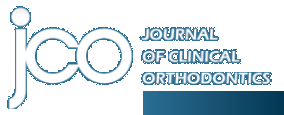Search Results For: 'orthodontics'
1881.
Clinical Efficiency of LightForce 3D-Printed Custom Brackets
Volume 57 : Number 5 : Page 274 : May 2023
A study by Dr. Waldman and colleagues compares the clinical performance of LightForce 3D-printed polycrystalline alumina brackets to that of conventional bracket systems. The average treatment time is found to be shorter in the LightForce group.
1882.
Volume 3 : Number 6 : Page 279 : Jun 1969
An event has occurred which has the most profound implications for orthodontists, indeed for all dentists. The New York Times of April 22, 1969 reported that the United States Supreme Court, in a 6 to...
1883.
THE EDITOR'S CORNER
Some Thoughts on Appointment Intervals
Volume 45 : Number 7 : Page 361 : Jul 2011
The length of time between orthodontic appointments, generally called the "appointment interval", has been the subject of debate for years. Various reasons have been given for selecting one interval o...
1884.
Practical Methods of Bonding: Direct and Indirect
Volume 9 : Number 10 : Page 610 : Oct 1975
Table of Contents I Advantages and Disadvantages of BondingA. Advantages B. Disadvantages II Requirements of a Good Adhesive A. Introduction to Protecto III Theoretical Considerations A. Principles of...
1885.
BOOK REVIEWS
Volume 36 : Number 1 : Page 29 : Jan 2002
ANTHONY A. GIANELLY, DMD, PHD, MD256 pages, 128 illustrations. $225. 2000.GAC International, Inc.185 Oval DriveCentral Islip, NY 11722(800) 645-5530; www.gacintl.com. The Bidimensional Technique was m...
1886.
Clinical Applications of Electrothermal Bonding
Volume 29 : Number 4 : Page 0 : Apr 1995
The acid-etch technique for bonding orthodontic brackets became generally accepted in the late 1970s.1 However, despite the modifications and refinements that have since taken place, the procedure for...
1887.
Volume 18 : Number 6 : Page 427 : Jun 1984
For many years I have believed that orthodontists face two challenges throughout their professional lives. The first is to develop a source of patients at a level sufficient to provide some measure of...
1888.
Volume 22 : Number 2 : Page 0 : Feb 1988
If management of an orthodontic practice is to be a positive function and not a haphazard endeavor carried wherever it goes by random choices or lack of choices, there must be planning. Planning by se...
1889.
Digital Design and Manufacturing of the Lingualcare Bracket System
Volume 39 : Number 6 : Page 375 : Jun 2005
The first lingual orthodontic systems, introduced in the early 1970s, used conventional labial brackets that were modified by the clinician and bonded directly to the lingual surfaces. Brackets design...
1890.
THE CUTTING EDGE
A Synthetic Three-Dimensional Craniofacial Analysis
Volume 44 : Number 11 : Page 673 : Nov 2010
(Editor's Note: This quarterly column is compiled by JCO Technology Editor Ronald Redmond. To help keep our readers on The Cutting Edge, Dr. Redmond will spotlight a particular area of orthodontic tec...
1891.
THE EDITOR'S CORNER
Volume 19 : Number 10 : Page 701 : Oct 1985
To Market, To MarketMany orthodontists seem unable to differentiate marketing from advertising. While advertising can be a part of marketing, it is only a small part--important though it may be to a g...
1892.
ROUND TABLE The Edgelok Bracket
Volume 6 : Number 11 : Page 613 : Nov 1972
Orthodontics is a creative and inventive speciality which often offers us either the opportunity or the necessity to improvise and innovate. JCO decided to investigate this whole process of how an inv...
1893.
TECHNIQUE CLINIC
Volume 40 : Number 7 : Page 418 : Jul 2006
Surgical-orthodontic treatment of a skeletal Class III patient is always challenging because of the severity of the malocclusion. To develop the orthodontic treatment plan, the clinician needs to asse...
1894.
Volume 8 : Number 3 : Page 129 : Mar 1974
There is a theory in dentistry which insists that the general dentist is in charge of the patient's oral health. He orchestrates the patient's treatment and he decides when specialty work is required;...
1895.
More About the Universal Appliance
Volume 5 : Number 2 : Page 72 : Feb 1971
This paper may be considered a continuation of "The Universal Appliance Today", Parts I and II, published in the November and December 1969 issues of JPO. Some of the drawings have been adapted from t...
1896.
Treatment of Class III Relapse Due to Late Mandibular Growth Using Miniscrew Anchorage
Volume 42 : Number 7 : Page 400 : Jul 2008
Skeletal Class III malocclusion can be treated in growing patients with either fixed or orthopedic appliances.1-6 Premolar extractions are often required in adolescents with both anterior crossbite an...
1897.
CASE REPORT
Nonsurgical Treatment of an Adult with Severe Anterior Open Bite
Volume 45 : Number 6 : Page 341 : Jun 2011
Open bites associated with digit-sucking habits and tongue thrust are mainly dental in nature and can usually be managed with Habit interception and orthodontic treatment. If such habits continue into...
1898.
Volume 17 : Number 4 : Page 253 : Apr 1983
Time is truly a gift given to us one minute at a time. We can spend money and then make more, but when a minute or a day is gone, it can never be retrieved. Time cannot be accumulated or stockpiled li...
1899.
Volume 53 : Number 3 : Page 154 : Mar 2019
The effects of two accelerative techniques on treatment time and pain experienced by bimaxillary protrusion patients during canine retraction are assessed in this prospective, double-blind, split-mouth controlled clinical trial by Drs. Maurya, Singh, Kapoor, Jain, and Mitra.
1900.
Common Sense Mechanics, Part 16
Volume 14 : Number 12 : Page 855 : Dec 1980
(CONTINUED FROM PART 15) Q/A Q Is it your contention that you cannot program treatment sequences, because of variability of biologic response of the individual patient? A Negative. In general, I bel...
Showing 1881-1900 of 4092 results. Search completed in 0.091 seconds.

